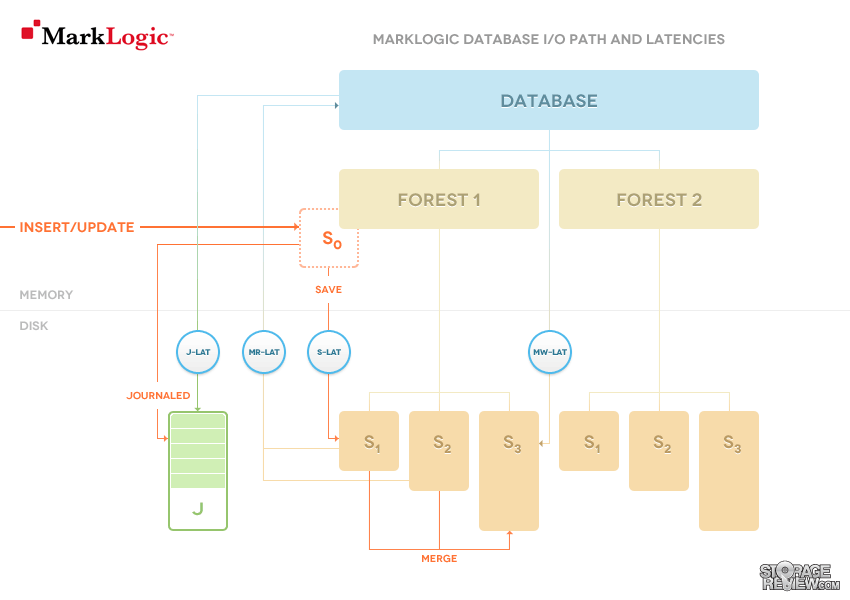
Working jointly with MarkLogic, StorageReview has developed the first actual NoSQL environment to benchmark storage that clearly illustrates the benefits of flash coupled with the industry’s fastest interconnect. Previous benchmarking efforts have simulated database workloads, but this is the first time we’ve been able to test against an actual NoSQL instance working against the best host-side flash solutions on the market today. Now MarkLogic customers can clearly see the stratification in performance and be able to select a storage solution qualified by StorageReview.com that meets their capacity, budgetary, and/or performance needs.
At the time of the MarkLogic NoSQL Benchmark launch, we’ve tested a wide range of storage devices meeting the >650GB available capacity required. These devices include single and multi-PCIe Application Accelerators, groups of four 2.5" SATA and SAS SSDs in a JBOD configuration, as well as groups of 16 SAS HDDs using either hardware or software RAID. With each of the storage solutions tested, the main focus is overall latency as seen by the MarkLogic NoSQL database in four areas: journal writes (J-lat), save writes (S-lat), as well as merge read (MR-lat) and merge write latency (MW-lat). Below is an outline of where each latency figure is measured in the MarkLogic database throughout the course of our test.
We have published the full results of the MarkLogic storage performance benchmark along with additional details about this test. Results will be updated on a rolling basis by StorageReview.com as new drives come to market or additional configurations are tested.
Full Release Below:
SAN CARLOS, Calif. — March 11, 2013 — MarkLogic Corporation, provider of ACID-compliant enterprise NoSQL (“not only SQL”) database solutions, and StorageReview.com, a world leading independent storage authority, today produced the first public results of StorageReview.com’s MarkLogic NoSQL Database Storage Benchmark test. This test illustrates the performance of flash storage, hard drive arrays and PCIe Application Accelerators running on MarkLogic. The benchmark provides MarkLogic customers with access to the latest storage performance data to guide their selection of new storage solutions for their NoSQL deployments.
“Previous benchmarking efforts just simulated database workloads, but the MarkLogic benchmark provides us with the first opportunity to test an actual NoSQL instance working against the best host-side flash solutions on the market today,” said Brian Beeler, Editor in Chief of StorageReview.com. “Our focus in this test is to look at overall latency from each examined storage solution across several performance factors.”
The MarkLogic NoSQL database has the flexibility and scalability to handle today’s data challenges that SQL-based databases were not designed to handle. It has enterprise-grade capabilities like search, ACID transactions, failover, replication, and security to run mission-critical applications. Any environment that faces the big data challenges of data volume, velocity, variety, and complexity can be enhanced with MarkLogic.
“This test enables our customers and prospects to evaluate the stratification in performance of various storage products being positioned as solutions for NoSQL environments,” said Denis Sheahan, Lead Performance Engineer at MarkLogic. “As a result, our customers will be able to easily select a storage solution qualified by StorageReview.com that meets their capacity, budgetary and/or performance needs.”
The benchmark is used to evaluate hardware configurations as well as upcoming MarkLogic software releases. The testing workload is divided into two distinct parts:
1. Ingestion phase where a large data set is inserted with indexes into the MarkLogic database.
2. Query phase where searches, views updates, and deletes are applied to the inserted data set. These queries also use MarkLogic features such as facets, pagination and bookmarks.
The benchmark test corpus uses the publicly available Wikipedia xml collection. Files are held on disk in zipped format, and the MarkLogic Content Pump (mlcp) is used to power an I/O intensive ingestion phase with the goal of generating the highest level of accuracy by forcing each device into steady-state availability. The focus of the test is to look at overall latency from each evaluated storage solution across four areas of interest: journal writes (J-lat), save writes (S-lat), as well as merge read (MR-lat) and merge write latency (MW-lat). Full benchmark test details can be found here.
As part of the benchmark, Mellanox InfiniBand interconnects were used to provide the highest performance and greatest network efficiency during testing. InfiniBand’s high-bandwidth, low-latency links allow for the greatest amount of data to be moved over the least number of links, allowing for the full system capabilities to be realized.
“Mellanox InfiniBand interconnects are designed to drive data volumes that are high enough to saturate the performance of tested platforms,” said Gilad Shainer, vice president of market development at Mellanox Technologies. “Only when all parts of a system are in balance, can the full performance potential of the overall system be achieved. Mellanox InfiniBand interconnects bring the data delivery connection up to par with MarkLogic’s flash-accelerated application performance, allowing for even higher performance in addition to increased infrastructure return on investment.”
The full results of the MarkLogic storage performance benchmark can be found here. Results will be updated on an ongoing basis by StorageReview.com as new drives come to market.
About MarkLogic Corporation
For more than a decade, MarkLogic has delivered a powerful and trusted enterprise NoSQL database that enables organizations to turn data into valuable and actionable information. Organizations around the world rely on MarkLogic’s enterprise-grade technology to make better decisions faster. MarkLogic is headquartered in Silicon Valley with field offices in Washington D.C., New York, Austin, London, Frankfurt, Utrecht, and Tokyo. For more information, please visit www.marklogic.com.
MarkLogic is a registered trademark of MarkLogic Corporation in the United States and/or other countries. All other trademarks mentioned are the property of their respective owners.
About StorageReview.com
Founded in 1998, StorageReview.com is a world leading independent storage authority, providing in-depth news coverage and detailed reviews on hard drives, SATA/SAS and PCIe SSDs, flash memory and the related hardware and software that make these storage solutions work. The publication is based in Cincinnati, OH.
About Mellanox
Mellanox Technologies is a leading supplier of end-to-end InfiniBand and Ethernet interconnect solutions and services for servers and storage. Mellanox interconnect solutions increase data center efficiency by providing the highest throughput and lowest latency, delivering data faster to applications and unlocking system performance capability. Mellanox offers a choice of fast interconnect products: adapters, switches, software and silicon that accelerate application runtime and maximize business results for a wide range of markets including high performance computing, enterprise data centers, Web 2.0, cloud, storage and financial services. More information is available at www.mellanox.com.

